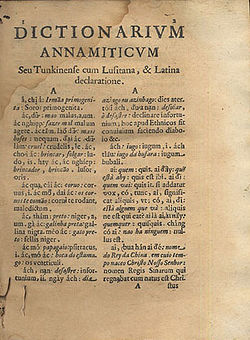Vietnamese alphabet



Vietnamese alphabet refers to the modern writing system used in Vietnam. It is an adaptation of the Latin alphabet but includes additional diacritics for tones and certain letters. The alphabet is known as chữ Quốc ngữ in Vietnamese, which translates to "national language script."
History[edit]
The Vietnamese alphabet was developed in the 17th century by Portuguese missionary Alexandre de Rhodes, who based it on the work of earlier missionaries. Its creation was part of an effort to facilitate the spread of Catholicism by making the Vietnamese language more accessible to Europeans. Before the adoption of the Latin script, Vietnamese was primarily written in chữ Nôm, a script that borrowed heavily from Chinese characters. The transition to the Latin alphabet helped to increase literacy rates in Vietnam, as it was easier to learn than the traditional characters.
Characteristics[edit]
The Vietnamese alphabet consists of 29 letters: 12 vowels and 17 consonants. Unlike the English alphabet, it includes the letters Đ/đ (representing the /d/ sound) and omits F, J, W, and Z. The alphabet also makes extensive use of diacritical marks to indicate tones and vowel distinctions. There are six tones in Vietnamese, each of which can significantly alter the meaning of a word. These tones are marked by diacritics placed above or below the vowels.
Vowels[edit]
The Vietnamese alphabet includes the following vowels: A, Ă, Â, E, Ê, I, O, Ô, Ơ, U, Ư, and Y. The use of diacritics creates additional vowel sounds, making the pronunciation of Vietnamese quite complex for learners.
Consonants[edit]
The consonants in the Vietnamese alphabet are B, C, D, Đ, G, H, K, L, M, N, P, Q, R, S, T, V, and X. The pronunciation of these consonants can vary depending on their position in a word and the regional dialect.
Tones[edit]
Vietnamese is a tonal language, and the meaning of a word can change based on the tone used. The six tones are:
- Level (ngang): no mark
- High rising (sắc): acute accent (´)
- Low falling (huyền): grave accent (`)
- High rising glottalized (hỏi): hook above (̉)
- Low falling glottalized (ngã): tilde (˜)
- Heavy (nặng): dot below (̣)
Usage[edit]
Today, the Vietnamese alphabet is used for all official documents, education, and media in Vietnam. It has facilitated the preservation of Vietnamese language and culture while also making it more accessible to non-Vietnamese speakers.
Challenges[edit]
Despite its advantages, the Vietnamese alphabet poses challenges for digital communication. The use of diacritical marks can lead to encoding issues on computers and the internet, where support for these characters is not always consistent.
Conclusion[edit]
The Vietnamese alphabet is a crucial aspect of the country's linguistic identity. It represents a successful adaptation of the Latin script to meet the unique phonetic and tonal requirements of the Vietnamese language. Its development and adoption have had a profound impact on literacy and education in Vietnam, making it a subject of interest in the study of linguistics and cultural history.

This article is a linguistics stub. You can help WikiMD by expanding it!
Ad. Transform your life with W8MD's Budget GLP-1 injections from $75


W8MD offers a medical weight loss program to lose weight in Philadelphia. Our physician-supervised medical weight loss provides:
- Weight loss injections in NYC (generic and brand names):
- Zepbound / Mounjaro, Wegovy / Ozempic, Saxenda
- Most insurances accepted or discounted self-pay rates. We will obtain insurance prior authorizations if needed.
- Generic GLP1 weight loss injections from $75 for the starting dose.
- Also offer prescription weight loss medications including Phentermine, Qsymia, Diethylpropion, Contrave etc.
NYC weight loss doctor appointmentsNYC weight loss doctor appointments
Start your NYC weight loss journey today at our NYC medical weight loss and Philadelphia medical weight loss clinics.
- Call 718-946-5500 to lose weight in NYC or for medical weight loss in Philadelphia 215-676-2334.
- Tags:NYC medical weight loss, Philadelphia lose weight Zepbound NYC, Budget GLP1 weight loss injections, Wegovy Philadelphia, Wegovy NYC, Philadelphia medical weight loss, Brookly weight loss and Wegovy NYC
|
WikiMD's Wellness Encyclopedia |
| Let Food Be Thy Medicine Medicine Thy Food - Hippocrates |
Medical Disclaimer: WikiMD is not a substitute for professional medical advice. The information on WikiMD is provided as an information resource only, may be incorrect, outdated or misleading, and is not to be used or relied on for any diagnostic or treatment purposes. Please consult your health care provider before making any healthcare decisions or for guidance about a specific medical condition. WikiMD expressly disclaims responsibility, and shall have no liability, for any damages, loss, injury, or liability whatsoever suffered as a result of your reliance on the information contained in this site. By visiting this site you agree to the foregoing terms and conditions, which may from time to time be changed or supplemented by WikiMD. If you do not agree to the foregoing terms and conditions, you should not enter or use this site. See full disclaimer.
Credits:Most images are courtesy of Wikimedia commons, and templates, categories Wikipedia, licensed under CC BY SA or similar.
Translate this page: - East Asian
中文,
日本,
한국어,
South Asian
हिन्दी,
தமிழ்,
తెలుగు,
Urdu,
ಕನ್ನಡ,
Southeast Asian
Indonesian,
Vietnamese,
Thai,
မြန်မာဘာသာ,
বাংলা
European
español,
Deutsch,
français,
Greek,
português do Brasil,
polski,
română,
русский,
Nederlands,
norsk,
svenska,
suomi,
Italian
Middle Eastern & African
عربى,
Turkish,
Persian,
Hebrew,
Afrikaans,
isiZulu,
Kiswahili,
Other
Bulgarian,
Hungarian,
Czech,
Swedish,
മലയാളം,
मराठी,
ਪੰਜਾਬੀ,
ગુજરાતી,
Portuguese,
Ukrainian